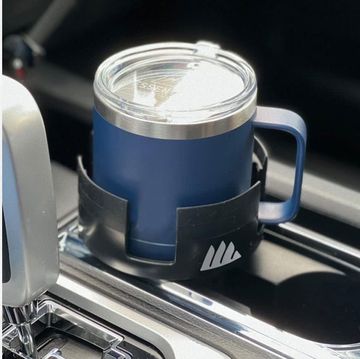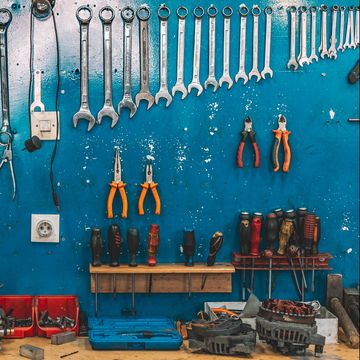There's a squeal emanating from underneath your hood—and it doesn't sound good. The noise started a few months ago, on a gray and rainy morning, but it went away before you even pulled out of the driveway. Problem solved, right? Sorry pal. Unfortunately, the noise was back the very next morning, and this time it lasted all the way to the corner of your block. You lifted the hood and zoomed in on the offending racket—it was the serpentine belt. As the weeks dragged on, your morning commute got noisier and noisier every day. Then you began to hear it on the way home too. Now it's a constant reminder to replace the belt. Soon.
Most modern cars don't use old-fashioned V-belts anymore. In the '70s, as more and more cars were optioned with lots of power-hungry accessories running off the crankshaft pulley, it often became necessary to have as many as four V-belts, each running a different gizmo. There just isn't room for that many belts and pulleys anymore—not to mention, this belt configuration means that it's a service nightmare to replace just the inner belt by itself. You'd have to remove the other three first—not a fun job.
There are several advantages to the new style of serpentine belts. A single belt, winding its way through a forest of pulleys, can now drive every single engine accessory at the same time. A single belt only an inch or so wide saves 3 or 4 in. of engine room real estate. Better still: Most of the serpentine-belt installations use a spring-loaded tensioner pulley that keeps a constant preload on the belt, eliminating the need to adjust the tension. If you've ever needed three hands and a tire iron to pry an alternator away from the block while simultaneously tightening the adjustment bolt-and-nut combo, you'll appreciate what a giant leap forward that is.
There's one last, very compelling advantage to serpentine belts: They don't wear out, at least not for a really long time. A fresh belt will probably last 150,000 miles without any maintenance at all. Contrast that with the expected 40,000- to 50,000-mile life span of a heavily loaded V-belt.
Failure Modes
So when, exactly, does one of these belts need to be replaced? Usually, you get plenty of warning before you hear the final Bad Noise, to wit, that squealing. A squealing noise is indicative of a problem, but might not require replacement of the belt. Misaligned pulleys or a seized tensioner or idler pulley can generate some noise as well.
A belt that's starting to disintegrate will show damage to the ribs or cords, which can usually be seen without dismantling anything. But you might need a flashlight and a dental mirror to see the fraying or cracking.
Fresh Belt
Start by studying the old belt's routing, which should be easy if the belt is still in place. But it's probably not so easy to spot if the belt is wadded up like macramé next to the a/c compressor's mounting bracket. Fear not: There should be a belt-routing placard under the hood. If the car has had bodywork or been repainted, the placard might have been covered. Look in the owner's manual; there's usually a routing diagram. With a half-dozen pulleys to choose from, it's possible, sometimes, to install the belt the wrong way. It might look right, but spinning the a/c compressor or water pump backwards isn't good. If the belt is hard to install or seems to fit poorly, you may have it routed incorrectly. Don't freak—sometimes the water pump is driven by the flat, back side of the belt. Any pulley that has grooves on it is intended to contact the grooved side of the belt. If you need to, sketch the correct routing down before you remove the old belt. As a last resort, check the shop manual.
|
An ordinary 3/8-in. extension and ratchet is used to unload the tensioner. Then you can just unthread the belt from around the pulleys. |
|
Left: Use a straightedge to see if all the pulleys are coplanar and square. If they're not, the new belt won't last long. Right: We used threadlocking compound to seal the new bolt that was provided with the tensioner. |
Most cars provide a common 3/8-in.-sq hole in the tensioner's arm to release the tensioner. Simply use a ratchet to loosen the belt, and unthread it from the pulleys.
Inspect the belt for damage. Cracks across the ribs are the most common indication of a belt that's simply at the end of its life span. Little rubber bands of rib, tufts of fiberglass reinforcing belt or disintegrating belt edges are indications of a problem with the pulleys, idlers or tensioners. A high-mileage belt that's just looking worn can simply be replaced. If there are other indications of damage from misalignment, get out the straightedge and make note of what isn't square.
A bent accessory-mounting bracket can make a pulley crooked, and you'll need to realign it. A steel bracket could be bent back into place, but a couple of shim washers might be a better option. If you're replacing a belt because of a fried alternator or seized a/c compressor, don't assume the new accessory or bracket will run true either.
Check the tensioner. The pulley should freewheel smoothly. The spring should have an appropriate amount of tension (which you can check with a belt tension gauge once the belt is installed), and there should be no friction in the pivot. Tensioner assemblies are usually not very expensive. Ditto for any idler pulleys, which should spin freely. We replaced the tensioner on our Suburban and added a drop of threadlocker to the bolt. The tensioner came with a new bolt—nice.
Is the area where the belt lives oily? Engine oil will rapidly degrade the rubber in the belt. Repair any leaky engine seals, like the crankshaft or camshaft front seal, or any gaskets—lest the new belt should go south in short order. Clean up any old oil too.
Check all the pulleys as well. Old rubber or dirt can build up in the bottom of the pulley grooves. You may need to clean the grooves with brake cleaner or a wire brush to remove any debris.
Buttoning Up
It's a simple matter to install a new tensioner and reinstall the belt, holding the tensioner slack with one hand as you thread the last pulley. Once the belt's in place, start the engine and let it idle for a minute or two. Check the belt tension by looking at the tensioner arm—the mark cast into the tensioner body will fall between the high and low marks if the belt is the correct part number and is installed properly.
|
Torque the new tensioner to the specified degree of tightness. Yes, that means with a torque wrench, not your carefully calibrated elbow. |
|
The hash mark on the body of the tensioner should fall between the high- and low-tension marks when the new belt is installed. |
If you removed any of the radiator shrouding to access the belt, don't neglect to reinstall it once you've finished. You certainly don't want any new noises coming from under the hood.













